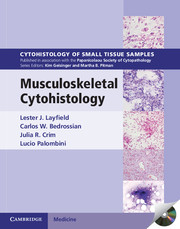Book contents
- Frontmatter
- Contents
- 1 Principles and practice for biopsy diagnosis and management of musculoskeletal lesions
- 2 Ancillary techniques useful in the evaluation and diagnosis of bone and soft tissue neoplasms
- 3 Spindle cell tumors of bone and soft tissue in infants and children
- 4 Spindle cell tumors of the musculoskeletal system characteristically occurring in adults
- 5 Giant cell tumors of the musculoskeletal system
- 6 Myxoid lesions of bone and soft tissue
- 7 Lipomatous tumors
- 8 Vascular tumors of bone and soft tissue
- 9 Pleomorphic sarcomas of bone and soft tissue
- 10 Osseous tumors of bone and soft tissue
- 11 Cartilaginous neoplasms of bone and soft tissue
- 12 Small round cell neoplasms of bone and soft tissue
- 13 Epithelioid and polygonal cell tumors of bone and soft tissue
- 14 Cystic lesions of bone and soft tissue
- Index
5 - Giant cell tumors of the musculoskeletal system
Published online by Cambridge University Press: 05 September 2013
- Frontmatter
- Contents
- 1 Principles and practice for biopsy diagnosis and management of musculoskeletal lesions
- 2 Ancillary techniques useful in the evaluation and diagnosis of bone and soft tissue neoplasms
- 3 Spindle cell tumors of bone and soft tissue in infants and children
- 4 Spindle cell tumors of the musculoskeletal system characteristically occurring in adults
- 5 Giant cell tumors of the musculoskeletal system
- 6 Myxoid lesions of bone and soft tissue
- 7 Lipomatous tumors
- 8 Vascular tumors of bone and soft tissue
- 9 Pleomorphic sarcomas of bone and soft tissue
- 10 Osseous tumors of bone and soft tissue
- 11 Cartilaginous neoplasms of bone and soft tissue
- 12 Small round cell neoplasms of bone and soft tissue
- 13 Epithelioid and polygonal cell tumors of bone and soft tissue
- 14 Cystic lesions of bone and soft tissue
- Index
Summary
INTRODUCTION
A variety of lesions containing foreign body type or osteoclast-like giant cells occur within bone and soft tissues. These tumors demonstrate a wide range of behavior from entirely benign inflammatory or autoimmune processes such as foreign body granulomas and the granulomas of rheumatoid arthritis to highly aggressive and metastasizing neoplasms originally characterized as malignant fibrous histiocytoma (MFH) and now more commonly termed pleomorphic sarcoma. The benign inflammatory or collagen vascular diseases usually occur in the superficial subcutaneous tissue or dermis and around joints, often within the synovium. Cytologic analysis is usually successful at separating the inflammatory/collagen vascular diseases from true neoplasms including nodular tenosynovitis, conventional giant cell tumor of bone, and the various forms of giant cell rich pleomorphic sarcoma.
FOREIGN BODY REACTION WITH A PROMINENT COMPONENT OF FOREIGN BODY TYPE GIANT CELLS
Clinical features
Foreign body type granulomas may occur within the dermis and subcutaneous tissues associated with the implantation of foreign material including wood splinters, sutures, glass, and metal fragments. Usually, an inciting injury is known but in some cases the etiology is cryptogenic. In many cases, the granulomas formed are non-caseating but in some instances, central necrosis is present.
- Type
- Chapter
- Information
- Musculoskeletal Cytohistology , pp. 92 - 113Publisher: Cambridge University PressPrint publication year: 2000

